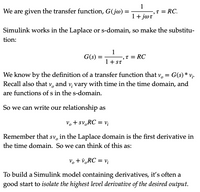
Introductory Circuit Analysis (13th Edition)
13th Edition
ISBN: 9780133923605
Author: Robert L. Boylestad
Publisher: PEARSON
expand_more
expand_more
format_list_bulleted
Concept explainers
Question
thumb_up100%
I am trying to model a simple RC circuit with one resistor and one capacitor using Simulink.
I was given this equation G(jw)=1/(1+jw*tau), tau=RC, and need to convert it to this form in the image: v_dot_o = 1/RC(Vi-Vo).
I have also attached a longer image with more detailed steps of how to get to the final equation, but I don't get how a derivative of Vo has appeared out of nowhere somewhere in the middle of the procedure. Please show as many steps as possible and explain the steps if necessary. I'm purely intending to learn from the process, so it'd be really nice if you could explain how each step was done!

Transcribed Image Text:1
We are given the transfer function, G(j@) =
T = RC.
1+ jøt'
Simulink works in the Laplace or s-domain, so make the substitu-
tion:
G(s)
1
T = RC
1 + ST
We know by the definition of a transfer function that v,
Recall also that v, and v; vary with time in the time domain, and
G(s) * Vị-
are functions of s in the s-domain.
So we can write our relationship as
V, + sv,RC = v;
Remember that sv, in the Laplace domain is the first derivative in
the time domain. So we can think of this as:
Vo + v,RC = v;
To build a Simulink model containing derivatives, it's often a
good start to isolate the highest level derivative of the desired output.

Transcribed Image Text:1
vo
(v; – v)
=
RC
Expert Solution
This question has been solved!
Explore an expertly crafted, step-by-step solution for a thorough understanding of key concepts.
Step by stepSolved in 2 steps

Knowledge Booster
Learn more about
Need a deep-dive on the concept behind this application? Look no further. Learn more about this topic, electrical-engineering and related others by exploring similar questions and additional content below.Similar questions
- A 10 KVA, 2400/240V, single phase transformer has the following resistances and leakage reactance Rp = 3-ohm Rs = 0.03-ohm Xp = 15-ohm Xs = 0.15-ohm Find the primary voltage required to produce 240V at the secondary terminals at full-load, when the load power factor is 0.8 lagging.arrow_forwardPlease in typing format please ASAP Thanks bro for your positive responsearrow_forward3- Analyze the system shown below to find the output waveform, Vout, assume the capacitor voltage value is -1.0 V at t-0 and RC-1 msec. -0.5 -1.0 V(1), V 1.0 0.5 R $ AAA f, msecarrow_forward
- Opamp circuitarrow_forwardRC circuit after the capacitor is charged, the switch is moved to dischsrge. The capacitor discharges through the resistance and voltage across the capacitor. Find time (t) if V=60V, R=1.0kΩ, & C=5µF. a. Vc=15V b. Vc=5.0Varrow_forwardPlease show me how to approach this problems with clear step be step work to solve the followingarrow_forward
- 37 A series RC circuit with R = 5 Kohms and C=20uF has a constant voltage source of 100V applied at t=0; there is no initial charge on the capacitor. Obtain the voltage across R for t>0. O ov -2000 e^-10t V -100 e^-10t V O -100 e^-10t + 100 Varrow_forwardHow do they know it is a first order rc circuit? What is a first order rc circuit?arrow_forwardselect all that applyarrow_forward
arrow_back_ios
arrow_forward_ios
Recommended textbooks for you
 Introductory Circuit Analysis (13th Edition)Electrical EngineeringISBN:9780133923605Author:Robert L. BoylestadPublisher:PEARSON
Introductory Circuit Analysis (13th Edition)Electrical EngineeringISBN:9780133923605Author:Robert L. BoylestadPublisher:PEARSON Delmar's Standard Textbook Of ElectricityElectrical EngineeringISBN:9781337900348Author:Stephen L. HermanPublisher:Cengage Learning
Delmar's Standard Textbook Of ElectricityElectrical EngineeringISBN:9781337900348Author:Stephen L. HermanPublisher:Cengage Learning Programmable Logic ControllersElectrical EngineeringISBN:9780073373843Author:Frank D. PetruzellaPublisher:McGraw-Hill Education
Programmable Logic ControllersElectrical EngineeringISBN:9780073373843Author:Frank D. PetruzellaPublisher:McGraw-Hill Education Fundamentals of Electric CircuitsElectrical EngineeringISBN:9780078028229Author:Charles K Alexander, Matthew SadikuPublisher:McGraw-Hill Education
Fundamentals of Electric CircuitsElectrical EngineeringISBN:9780078028229Author:Charles K Alexander, Matthew SadikuPublisher:McGraw-Hill Education Electric Circuits. (11th Edition)Electrical EngineeringISBN:9780134746968Author:James W. Nilsson, Susan RiedelPublisher:PEARSON
Electric Circuits. (11th Edition)Electrical EngineeringISBN:9780134746968Author:James W. Nilsson, Susan RiedelPublisher:PEARSON Engineering ElectromagneticsElectrical EngineeringISBN:9780078028151Author:Hayt, William H. (william Hart), Jr, BUCK, John A.Publisher:Mcgraw-hill Education,
Engineering ElectromagneticsElectrical EngineeringISBN:9780078028151Author:Hayt, William H. (william Hart), Jr, BUCK, John A.Publisher:Mcgraw-hill Education,

Introductory Circuit Analysis (13th Edition)
Electrical Engineering
ISBN:9780133923605
Author:Robert L. Boylestad
Publisher:PEARSON

Delmar's Standard Textbook Of Electricity
Electrical Engineering
ISBN:9781337900348
Author:Stephen L. Herman
Publisher:Cengage Learning

Programmable Logic Controllers
Electrical Engineering
ISBN:9780073373843
Author:Frank D. Petruzella
Publisher:McGraw-Hill Education

Fundamentals of Electric Circuits
Electrical Engineering
ISBN:9780078028229
Author:Charles K Alexander, Matthew Sadiku
Publisher:McGraw-Hill Education

Electric Circuits. (11th Edition)
Electrical Engineering
ISBN:9780134746968
Author:James W. Nilsson, Susan Riedel
Publisher:PEARSON

Engineering Electromagnetics
Electrical Engineering
ISBN:9780078028151
Author:Hayt, William H. (william Hart), Jr, BUCK, John A.
Publisher:Mcgraw-hill Education,